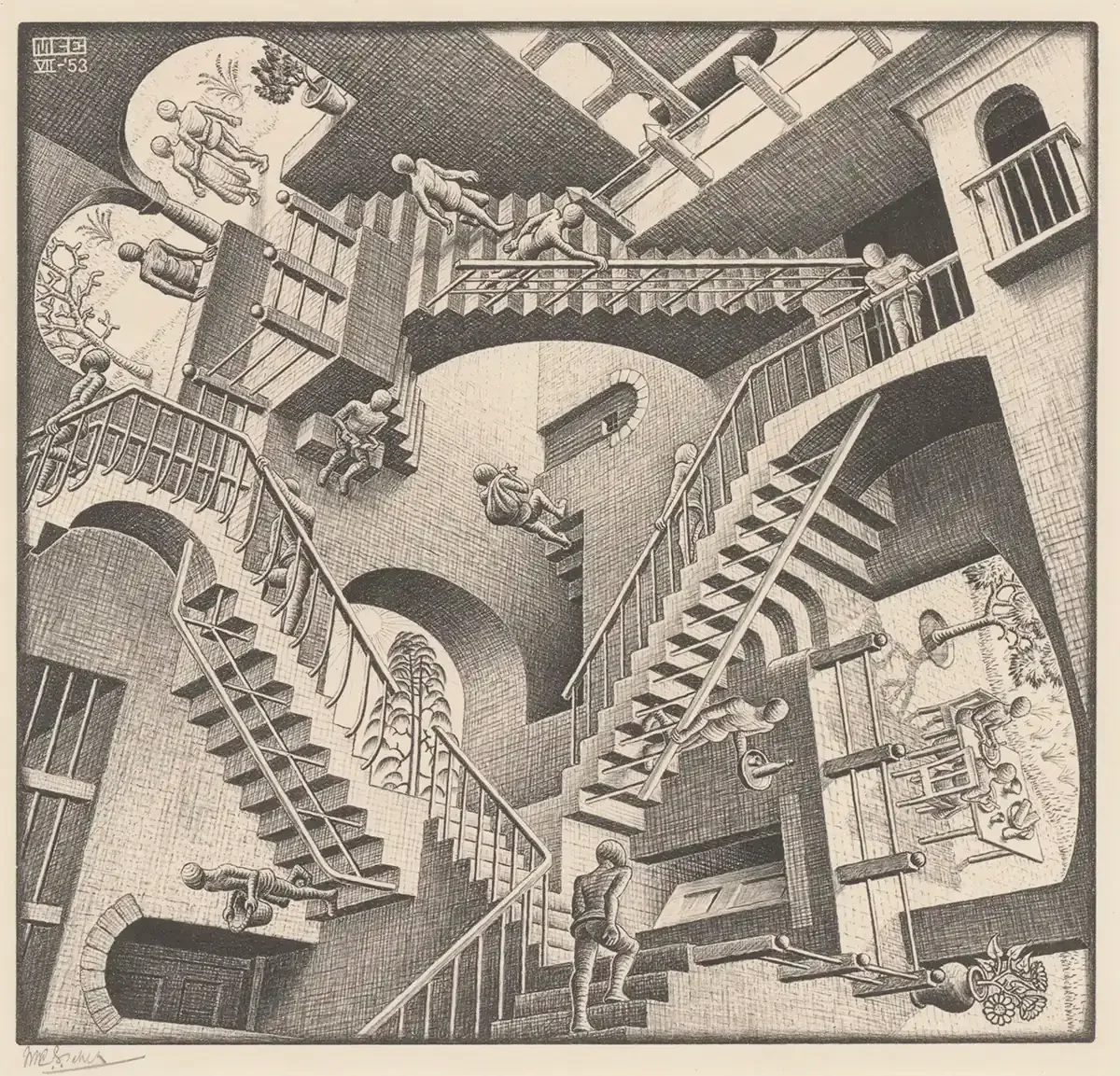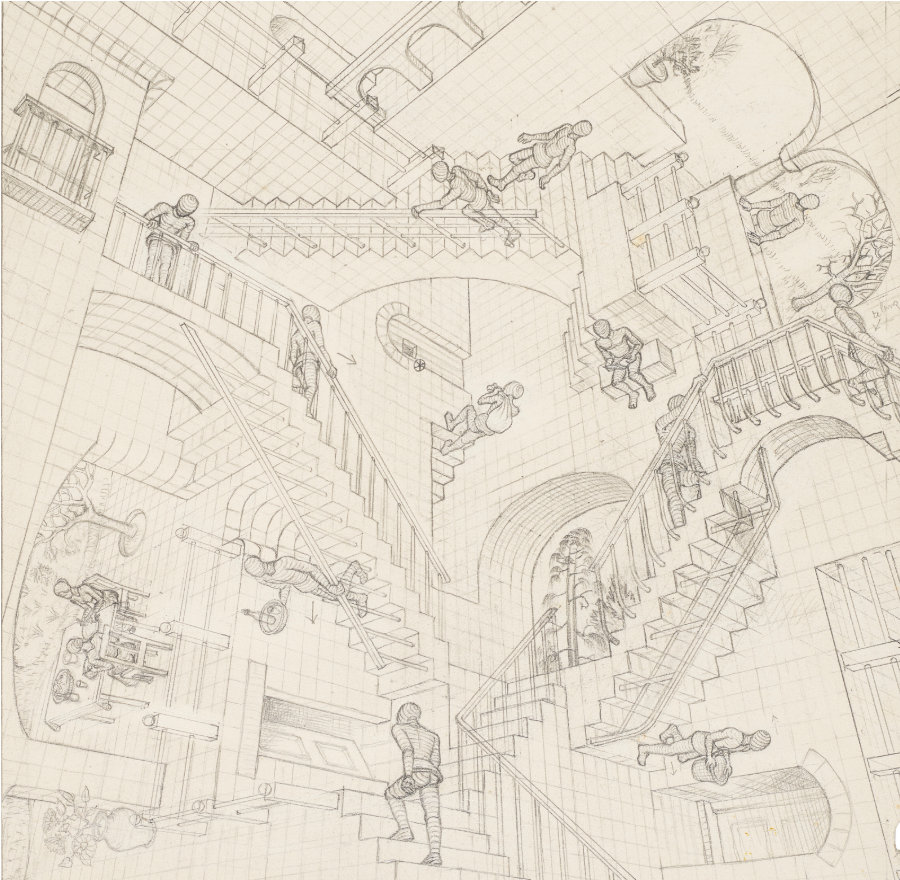Relativity (M.C. Escher): A World Where Gravity Has No Rules
Before continuing, please take a moment to really look at the work.
Among the many impossible worlds created by M.C. Escher, none is more famous than Relativity. First printed in 1953, this lithograph presents a scene that feels both architectural and dreamlike: staircases leading in every direction, figures climbing and descending in ways that make no sense, and three separate gravitational pulls coexisting in the same space.
The composition is so precise that, at first glance, it almost looks logical. Only when the eye lingers do the contradictions reveal themselves. Where one figure is walking comfortably on a staircase, another appears to be sideways; where one is climbing upward, another is descending toward the ceiling. Relativity is both orderly and chaotic, a place where the laws of physics bend into paradox.
How did Relativity come to life?
Escher created Relativity as a lithograph in 1953, during a mature phase of his career when impossible constructions had become a central theme. Earlier in his life he had focused on landscapes and tessellations, but by the 1950s he was increasingly drawn to architectural paradoxes. Works like Ascending and Descending and Waterfall would soon follow, forming a trilogy of sorts around impossible staircases and perpetually flowing motion.
The scene in Relativity is set in what looks like an architectural courtyard. Archways, terraces, and staircases interlock in a way that is carefully shaded and mathematically proportioned. The figures inhabiting this world are anonymous, identical, and strangely mechanical. They carry out simple, everyday actions — walking, sitting, climbing — but their movements, when taken together, make no sense. The effect is both mesmerizing and unsettling.
What Is the Meaning Behind Relativity by M.C. Escher?
The meaning of Relativity has been debated for decades, and part of its power lies in that ambiguity. On the surface, it is a visual puzzle, a demonstration of Escher’s mastery of perspective and paradox. The three gravitational fields — one vertical, one horizontal, one inverted — create a world that is impossible in reality but perfectly consistent within the print.
More broadly, the image can be read as a metaphor for the relativity of human perspective. What seems “up” to one figure is “sideways” or “down” to another. Each lives within their own frame of reference, oblivious to the others. It is a world of isolated routines, coexisting but never connecting. Some critics have even read it as a commentary on modern life: ordered, repetitive, yet strangely disconnected.
Escher himself avoided attaching explicit “meanings” to his works, preferring to let the images speak for themselves. But it is clear that Relativity embodies his fascination with paradox, perspective, and the limits of human perception
What Genre Is Relativity by M.C. Escher?
Relativity is usually classified as part of the genre of mathematical art or impossible constructions. Unlike Escher’s tessellations, which are rooted in geometry and pattern, this work belongs to his series of architectural paradoxes. It also has ties to Surrealism, though Escher himself resisted that label, insisting that his art was rooted in logic rather than subconscious dream.
In an art-historical sense, Relativity belongs to no single movement. It is part of what makes Escher unique: his images stand apart from the mainstream avant-garde of his era, occupying a space between art, mathematics, and philosophy.
What Is M.C. Escher’s Most Famous Piece?
While Escher produced many famous works — Drawing Hands, Waterfall, Sky and Water I — Relativity is arguably his most iconic.
It appears on posters, book covers, and album art, and has been referenced in countless films, advertisements, and even video games. Its combination of visual clarity, architectural precision, and impossible logic makes it instantly memorable.
The fact that Relativity is often cited as his most famous piece also reflects its accessibility. Some of Escher’s works, such as the long Metamorphosis woodcuts, require time and context to appreciate fully. Relativity, by contrast, delivers its paradox in a single glance — an image both puzzling and unforgettable.
What Is the Link Between Escher and Infinity?
Infinity was a theme that fascinated Escher throughout his career. His tessellation prints, such as Circle Limit III, explore how shapes can repeat endlessly in hyperbolic space, shrinking toward infinity. His Metamorphosis series shows one form transforming into another in a cycle that seems to have no end.
While Relativity does not directly depict infinity, it shares the same conceptual DNA. The staircases form loops that figures can walk forever without progress, creating an infinite cycle of meaningless motion. The world of Relativity has no clear beginning or end, no resolution or escape. In this sense, it echoes Escher’s broader interest in infinity as both a mathematical and philosophical idea — endlessness contained within a finite frame.
Relativity in Popular Culture
Few of Escher’s works have had as much cultural impact as Relativity. The image has been referenced in films such as Labyrinth and Inception, in episodes of The Simpsons, and in countless album covers and advertisements. Video game designers, in particular, have been drawn to its world of impossible geometry, inspiring levels and mechanics that deliberately play with gravity and perspective.
This widespread influence underscores how deeply Relativity has entered the public imagination. It is not just an artwork but a cultural touchstone; a shorthand for paradox, illusion, and the unsettling beauty of the impossible.
In season 6, episode 12 of The Simpons, the couch gag is an homage to M.C. Escher’s Relativity
Collecting Relativity
Authentic Relativity lithographs are highly sought after on the art market. As with other Escher prints, they are usually signed “MCE” in pencil, sometimes with edition numbers. Condition and provenance are crucial: clean impressions from early editions command the highest prices, while later reprints and reproductions are far more common.
Collectors value Relativity not only for its fame but for its place within Escher’s “impossible building” period, alongside Ascending and Descending and Waterfall. Owning one of these prints means holding a piece of the trilogy that defines Escher’s exploration of architectural paradox.
Conclusion
Relativity stands as a pinnacle of M.C. Escher’s career. It combines mathematical rigor with artistic imagination, order with impossibility. By bending the laws of perspective, Escher created a world where three gravitational pulls coexist, where figures walk endlessly without connection, and where paradox becomes beautiful.
For many, it is his most famous work, the image that defines him. For others, it is part of a larger body of explorations into infinity, symmetry, and transformation. Either way, Relativity remains timeless, a lithograph that continues to fascinate mathematicians, artists, and anyone who has ever wondered what it would be like to walk up a staircase that leads nowhere.


